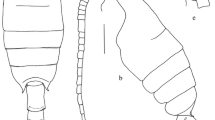Abstract
Alentiana has only one member, A. aurantiaca (Verrill, 1885), commensal with sea anemone (Bolocera tuediae). Here, Alentiana palinpoda sp. nov., a second member in the genus Alentiana (subfamily Lepidastheniinae), a new commensal polynoid is described, based on a specimen collected from a deep-water seamount in the Northwest Pacific Ocean. The new species is characterized by large elytra that completely cover the dorsum and are present in every third segment in the posterior regions. Neuropodia are truncated, with two types of neurochaetae; supraacicular chaetae toothed on one side with a slightly inflated end, and subacicular chaetae that are heavy and smooth; the prechaetal lobe is larger than the postchaetal lobe, with the ventral part rolling upward and backward.
Similar content being viewed by others
References
Bankevich A, Nurk S, Antipov D, et al. 2012. SPAdes: a new genome assembly algorithm and its applications to single-cell sequencing. Journal of Computational Biology, 19(5): 455–477, doi: https://doi.org/10.1089/cmb.2012.0021
Bellan G. 2001. Polychaeta. In: Costello M J, Emblow C, White R J, eds. European Register of Marine Species: A Check-List of the Marine Species in Europe and a Bibliography of Guides to their Identification. Collection Patrimoines Naturels, 50: 214–231
Bernt M, Donath A, Jühling F, et al. 2013. MITOS: improved de novo metazoan mitochondrial genome annotation. Molecular Phylogenetics and Evolution, 69(2): 313–319, doi: https://doi.org/10.1016/j.ympev.2012.08.023
Bonifácio P, Menot L. 2019. New genera and species from the Equatorial Pacific provide phylogenetic insights into deep-sea Polynoidae (Annelida). Zoological Journal of the Linnean Society, 185(3): 555–635, doi: https://doi.org/10.1093/zoolinnean/zly063
Cock P J A, Chilton J M, Grüning B, et al. 2015. NCBI BLAST+ integrated into Galaxy. GigaScience, 4(1): 39, doi: https://doi.org/10.1186/s13742-015-0080-7
Gonzalez B C, Martínez A, Borda E, et al. 2018. Phylogeny and systematics of Aphroditiformia. Cladistics, 34(3): 225–259, doi: https://doi.org/10.1111/cla.12202
Guindon S, Dufayard J F, Lefort V, et al. 2010. New algorithms and methods to estimate maximum-likelihood phylogenies: Assessing the performance of PhyML 3.0. Systematic Biology, 59(3): 307–321, doi: https://doi.org/10.1093/sysbio/syq010
Hartman O. 1942. A review of the types of Polychaetous Annelids at the Peabody Museum of Natural History, Yale University. Bulletin of the Bingham Oceanographic Collection, 8: 1–98
Hatch A S, Liew H, Hourdez S, et al. 2020. Hungry scale worms: Phylogenetics of Peinaleopolynoe (Polynoidae, Annelida), with four new species. Zookeys, 932: 27–74, doi: https://doi.org/10.3897/zookeys.932.48532
Norlinder E, Nygren A, Wiklund H, et al. 2012. Phylogeny of scale-worms (Aphroditiformia, Annelida), assessed from 18S rRNA, 28S rRNA, 16S rRNA, mitochondrial cytochrome c oxidase subunit I (COI), and morphology. Molecular Phylogenetics and Evolution, 65(2): 490–500, doi: https://doi.org/10.1016/j.ympev.2012.07.002
Pettibone M H. 1963. Marine polychaete worms of the New England region: I. Aphroditidae through Trochochaetidae. Bulletin of the United States National Museum, 227: 1–356
Pettibone M H. 1989. A new species of Benhamipolynoe (Polychaeta: Polynoidae: Lepidastheniinae) from Australia, associated with the unattached stylasterid coral Conopora adeta. Proceedings of the Biological Society of Washington, 102(2): 300–304
Salazar-Vallejo S I, González N E, Salazar-Silva P. 2015. Lepidasthenia loboi sp. n. from Puerto Madryn, Argentina (Polychaeta, Polynoidae). ZooKeys, 546: 21–37, doi: https://doi.org/10.3897/zookeys.546.6175
Sui Jixing, Li Xinzheng, Kou Qi. 2019. A new species of the genus Intoshella Darboux, 1899 (Polychaeta: Polynoidae) commensal with a deep-sea sponge from a seamount near the Mariana Trench. Marine Biodiversity, 49(3): 1479–1488, doi: https://doi.org/10.1007/s12526-018-0922-5
Trifinopoulos J, Nguyen L T, von Haeseler A, et al. 2016. W-IQ-TREE: a fast online phylogenetic tool for maximum likelihood analysis. Nucleic Acids Research, 44(W1): W232–W235, doi: https://doi.org/10.1093/nar/gkw256
Verrill A E. 1885. Notice of recent additions to the marine Invertebrata of the northeastern coast of America, with descriptions of new genera and species and critical remarks on others: Part V. Annelida, Echinodermata, Hydroida, Tunicata. Proceedings of the United States National Museum, 8(27/28): 424–448
Wehe T. 2006. Revision of the scale worms (Polychaeta: Aphroditoidea) occurring in the seas surrounding the Arabian Peninsula: Part I. Polynoidae. Fauna of Arabia, 22: 23–197
Wu Xuwen, Zhan Zifeng, Xu Kuidong. 2019. Two new and two rarely known species of Branchinotogluma (Annelida: Polynoidae) from deep-sea hydrothermal vents of the Manus Back-Arc basin, with remarks on the diversity and biogeography of vent polynoids. Deep Sea Research Part I: Oceanographic Research Papers, 149: 103051, doi: https://doi.org/10.1016/j.dsr.2019.05.011
Zhang Yanjie, Chen Chong, Qiu Jianwen. 2018a. Sexually dimorphic scale worms (Annelida: Polynoidae) from hydrothermal vents in the Okinawa trough: Two new species and two new sex morphs. Frontiers in Marine Science, 5: 112, doi: https://doi.org/10.3389/fmars.2018.00112
Zhang Yanjie, Sun Jin, Rouse G W, et al. 2018b. Phylogeny, evolution and mitochondrial gene order rearrangement in scale worms (Aphroditiformia, Annelida). Molecular Phylogenetics and Evolution, 125: 220–231, doi: https://doi.org/10.1016/j.ympev.2018.04.002
Zhou Yadong, Wang Yueyun, Zhang Dongsheng, et al. 2018. Branchinotogluma bipapillata n. sp., a new branchiate scale worm (Annelida: Polynoidae) from two hydrothermal fields on the Southwest Indian Ridge. Zootaxa, 4482(3): 527–540, doi: https://doi.org/10.11646/zootaxa.4482.3.5
Acknowledgements
We thank the crew of R/V Dayang Yihao and technical staff of Hailong III ROV for their great help during the investigation. We thank Yang Li for his assistance in sea anemone identification.
Funding
The National Natural Science Foundation of China under contract No. 41806179; the China Ocean Mineral Resources Research and Development Association Program under contract Nos DY135-E2-2-03 and DY135-E2-2-07.
Author information
Authors and Affiliations
Corresponding author
Rights and permissions
About this article
Cite this article
Wang, Y., Cheng, H. & Wang, C. Alentiana palinpoda, a new commensal polynoid species from a seamount in the Northwest Pacific Ocean. Acta Oceanol. Sin. 40, 12–19 (2021). https://doi.org/10.1007/s13131-021-1888-x
Received:
Accepted:
Published:
Issue Date:
DOI: https://doi.org/10.1007/s13131-021-1888-x




